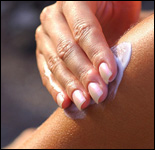Current Features
May is Skin Cancer Awareness Month

Skin cancer is the most common form of cancer in the United States.
The two most common types of skin cancer (basal cell and squamous cell carcinomas) are highly curable. However, melanoma, the third most common skin cancer, is more dangerous, especially among young people. In 2004*, 50,039 people in the United States were diagnosed with melanoma, while 7,952 people died of this kind of skin cancer. †
Exposure to the sun's ultraviolet (UV) rays appears to be the most important environmental factor involved in the development of skin cancer. When used consistently, sun-protective practices can prevent skin cancer.
Protect your skin from the sun at work and play

It's not only baking on a beach or broiling beside a pool that increases the risk of skin cancer. If you spend time outside in the sun while working, boating, fishing, gardening, camping, playing sports, or just relaxing, you need to protect your skin from the sun.
CDC recommends five easy options for sun protection:
• Seek shade, especially during midday hours (10:00 a.m.–4:00 p.m.), when UV rays are strongest and do the most damage.
• Cover up with clothing to protect exposed skin.
• Get a hat with a wide brim to shade the face, head, ears, and neck.
• Grab shades that wrap around and block as close to 100% of both UVA and UVB rays as possible.
• Rub on sunscreen with sun protective factor (SPF) 15 or higher, and both UVA and UVB protection.
Tanning beds and sunlamps emit UV rays that are as dangerous as those from the sun and, therefore, should also be avoided.
Remember, both tanning and burning can increase a person's risk of skin cancer.
Other Risk Factors

People with certain risk factors are more likely than others to develop skin cancer. Risk factors include:
• Lighter natural skin color.
• Family history of skin cancer.
• Personal history of skin cancer.
• Exposure to the sun through work and play.
• A history of sunburns early in life.
• Skin that burns, freckles, reddens easily, or becomes painful in the sun.
• Blue or green eyes.
• Blond or red hair.
• Certain types and a large number of moles.
For more information
- Basic Information about Skin Cancer
- CDC 2006/2007 Skin Cancer Prevention and Education Initiative Fact Sheet
- Sun Safety at Schools (
 179KB)
179KB) - Shade Planning for Schools (
 1.2MB)
1.2MB) - Melanoma
- Cáncer de piel
* The most recent year for which statistics are currently available.
† U.S. Cancer Statistics Working Group. United States Cancer Statistics: 2004 Incidence and Mortality. Atlanta: U.S. Department of Health and Human Services, Centers for Disease Control and Prevention and National Cancer Institute; 2007.
Page last updated: May 5, 2008
Content source: Division of Cancer Prevention and Control, National Center for Chronic Disease Prevention and Health Promotion
Content owner: National Center for Health Marketing
URL for this page: www.cdc.gov/Features/SkinCancer

